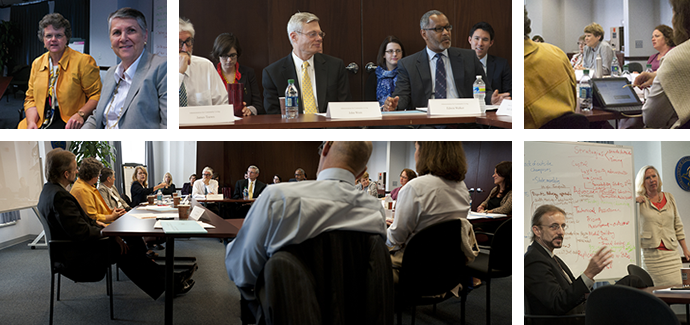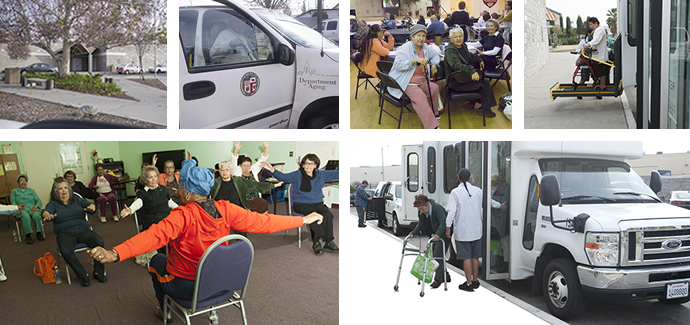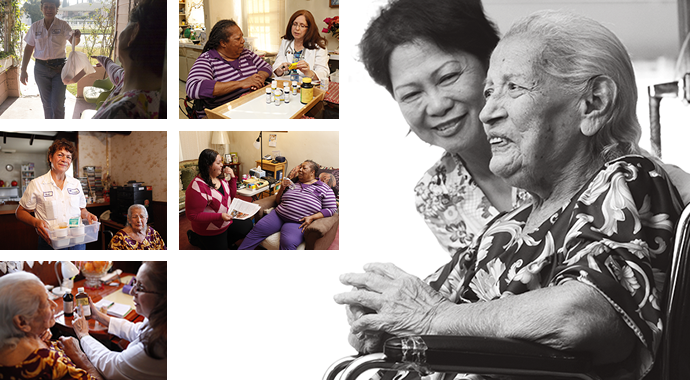Better Together: Building an Integrated Healthcare and Social Services Delivery System
What W. June Simmons, MSW, president and CEO of the Partners in Care Foundation, calls “the transformational redesign of healthcare reimbursement” offers a unique opportunity to break down barriers that have long separated medical services and community-based social service agencies.
“They’re moving everybody’s cheese all at once,” says Ms. Simmons (Building a Powerful Team), noting the dislocations and dynamism that characterize today’s healthcare system, with a nod to Spencer Johnson’s influential book about dealing with change.
Fact: There are an estimated 950,000 adults aged 65 and older in Los Angeles County.
Nearly one in three (32.5 percent) older people in Los Angeles report their health as fair or poor.
These changes are creating new challenges—and opportunities. Partners in Care Foundation, based in San Fernando, CA, is developing a large-scale, prototype network that links community-based, social service agencies to the healthcare sector, with the goal of establishing an integrated healthcare and social services delivery system. As part of the grant, the longtime Hartford grantee is also collaborating with Elder Services of the Merrimack Valley and Hebrew SeniorLife to develop a second collaborative network in Massachusetts.
This is the type of complex, ambitious project that benefits from a variety of partners. And it clearly demonstrates how collaboration can greatly extend the reach and impact of their work for change.
Over the years, the Hartford Foundation has collaborated with Partners in Care on numerous projects, building a strong working relationship based on mutual trust and shared vision.
As the Foundation was planning the California project with Partners in Care, Hartford was approached by the Tufts Health Plan Foundation, which was looking for a matching grant for a similar project with Elder Services of the Merrimack Valley and Hebrew SeniorLife in Massachusetts. By incorporating the Massachusetts project, Hartford’s $2,068,500 grant became part of a $4,010,846 million, three-year project with a site on each coast.
 (Above) ACL leaders, funders, and stakeholders convene to develop partnerships for community-based programs (see photos below). (Clockwise) Kathy Greenlee, Assistant Secretary of the Administration for Community Living (ACL) and Corinne Rieder, EdD, Hartford Foundation ED and Treasurer. Key ACL leaders James Toews, John Wren, and Edwin Walker, JD. W. June Simmons of Partners in Care Foundation shares her views. Nora OBrien-Suric, PhD, Hartford Senior Program Officer addresses the group. René Seidel, Vice President, Programs and Operations, SCAN Foundation, and Mary Clare (Mimi) Toomey, ACL facilitate the discussion.
(Above) ACL leaders, funders, and stakeholders convene to develop partnerships for community-based programs (see photos below). (Clockwise) Kathy Greenlee, Assistant Secretary of the Administration for Community Living (ACL) and Corinne Rieder, EdD, Hartford Foundation ED and Treasurer. Key ACL leaders James Toews, John Wren, and Edwin Walker, JD. W. June Simmons of Partners in Care Foundation shares her views. Nora OBrien-Suric, PhD, Hartford Senior Program Officer addresses the group. René Seidel, Vice President, Programs and Operations, SCAN Foundation, and Mary Clare (Mimi) Toomey, ACL facilitate the discussion.
The Tufts Health Plan Foundation is supporting the Massachusetts collaboration with $750,000 in funding, while the Archstone Foundation is contributing $225,000 to support the California network. In addition, Partners in Care Foundation—the direct grantee and primary project leader—is contributing a matching $521,173 in cash and in-kind contributions.
The U.S. Administration for Community Living (ACL) is also joining the “party,” demonstrating how a non-funding partner can play a critical role. ACL will provide valuable technical assistance and training to enable the social service providers in the aging network to collaborate and contract with each other, as well as with health care providers and health insurance plans. ACL’s participation is part of a broader collaborative effort that will share tools and lessons among the Hartford-funded networks and seven other similar networks across the country

(Above) Alicia Broadus, Duncan Multipurpose Senior Center, Pocoima, CA. Older adults and people with disabilities must be able to participate freely in social activities and have transportation access to health services. Social service networks bring people to services and services to people. Classes at a senior center in Pocoima, CA. Seniors enjoy low-impact exercises to increase joint flexibility and range of motion, and maintain muscle strength in the evidence-based Arthritis Foundation Exercise Program.
(Below) Home visits. Quality of life for the homebound includes safety, nutrition, exercise, medication management, and social contacts. Social service networks are key members in the coordinated care system they need.

As new health systems emerge covering large geographic areas and huge populations, community-based social service agencies—and the evidence-based services they provide—are fighting to enhance healthcare services. The large for-profit and nonprofit corporations dominating the health landscape have capital, information technology, impressive sales capabilities, and the ability to carry risk.
Community-based service agencies may not be able to compete on those terms, Ms. Simmons says, but they have something the large health systems don’t: “We have feet on the ground that are very valuable. We have linguistic and cultural capabilities. We have deep knowledge of what’s in the community. We’re trusted, and we can get into people’s homes to help them. So we have some assets we can compete with, and we’re trying to mobilize that.”
In identifying community-based agencies to join in the prototype networks, Ms. Simmons says, it is important to find people and groups “…who really understand that you’re going to have to move to working with doctors’ practices and with health insurers and with hospitals, which is new for the community agencies. And they need to see that that’s a great opportunity to improve the way we care for people. It’s about alignment of vision and purpose, and ultimately, a common understanding of what the problems and the solutions are.”
Developing this kind of alignment will not be simple, she notes, but it is one of the hallmarks of successful partnerships.
“ We’re trying to create regional delivery systems of community services organizations that can work together across a range of services and resources because it’s such a fragmented system... if we can build organizational structures that are integrated, there would be less fragmentation to manage.” W. June Simmons, MSW
President and CEO
Partners in Care Foundation